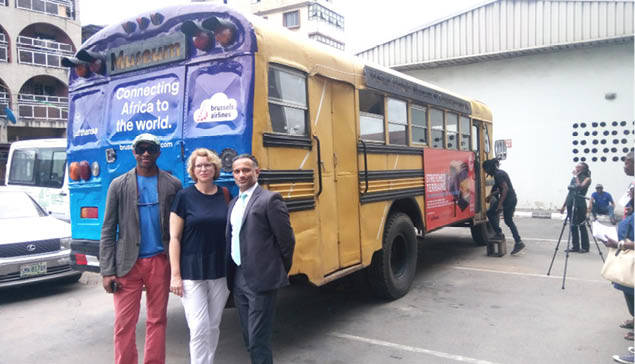Museums should be avenues for info exchange – Möschel, Goethe-Institut
Friederike Möschel, is the Director of Goethe-Institut Nigeria. In this interview she speaks about Nigeria’s participation and the Molue Mobile Museum of Contemporary Art Lagos at the ongoing international exhibition, Dak’Art in Dakar, Senegal. How did the concept of using a molue come about? The Nigerian artist Emeka Udemba, who works and lives in […]


Friederike Möschel, is the Director of Goethe-Institut Nigeria. In this interview she speaks about Nigeria’s participation and the Molue Mobile Museum of Contemporary Art Lagos at the ongoing international exhibition, Dak’Art in Dakar, Senegal.
How did the concept of using a molue come about?
The Nigerian artist Emeka Udemba, who works and lives in Germany, had the idea to transform an old school bus into a mobile museum in 2014. Together with the Goethe-Institut Nigeria, he founded the Molue Mobile Museum of Contemporary art Lagos, (MMMoCA). Emeka Udemba has the opinion that the traditional concepts of museums and public spaces don’t work in most African countries the way they should. He believes that everybody needs culture and creative impulses, not just a specific group of citizens who live close by a museum. A museum should not only be a space where old artefacts are kept but a venue for public exchange, discussions, which is open for experiments. The mobile museum bus provides such a platform.
What is the basis for which the participating artists are chosen?
First of all, it was important to select artists from various disciplines, who already had experience in collaborative structures. Second, they should be aware that this journey is not like an all-inclusive group trip but quite a physical and mental challenge.
Apart from the fact that the artists may be exhibiting at Dak’Art which is to an international audience, could say specifically how the project makes contemporary art more accessible to the public as a mainstream element of the Nigerian social life and to de-eliticize the locations of creative encounters.
The bus will cross six western African countries and will not only stop in the capitals but also in smaller towns and remote villages. The bus is open to everyone, who is interested to enter: During its last journey in 2016, small children, teenagers and also the village elders were curious and wanted to know more about the project and the artists. It is a difference if you enter a posh, impressive museum or an old school bus, which you probably still remember from your old school days.
The release you shared said, “MMMoCA provides creative spaces that challenge perceptions, interrogates society and sees the world not just through our own eyes, but through the eyes of others.” How does this happen?
Through the interaction between the artists, coming from different countries, and between the people, they will meet during the journey, and the artist group.
Beyond the biennale and the journey there and back, does MMMoCA provide a mentorship platform or some other kind of continuity where experiences and/or lessons are shared or further harnessed?
This is not the target of the project: They will have presentations on their way back at all the Goethe-Instituts along the way (Senegal, Mali, Cote D’Ivoire, Ghana, Togo and back in Lagos).
